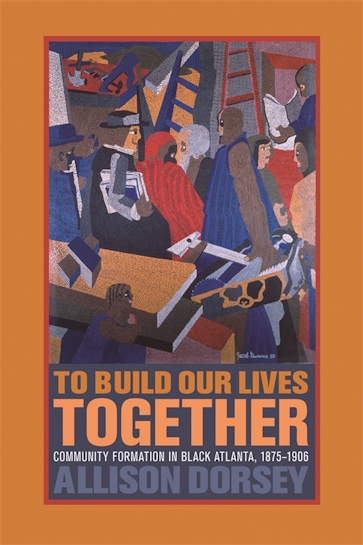To Build Our Lives Together
Community Formation in Black Atlanta, 1875-1906
Title Details
Pages: 242
Illustrations: 19 b&w photos and 2 figures
Trim size: 6.000in x 9.000in
Formats
Paperback
Pub Date: 07/08/2004
ISBN: 9-780-8203-2619-1
List Price: $29.95
Related Subjects
Other Links of Interest
• Learn more about the 1906 Atlanta Race Riot at the New Georgia Encyclopedia
To Build Our Lives Together
Community Formation in Black Atlanta, 1875-1906
Skip to
- Description
- Reviews
After Reconstruction, against considerable odds, African Americans in Atlanta went about such self-interested pursuits as finding work and housing. They also built community, says Allison Dorsey. To Build Our Lives Together chronicles the emergence of the network of churches, fraternal organizations, and social clubs through which black Atlantans pursued the goals of adequate schooling, more influence in local politics, and greater access to municipal services. Underpinning these efforts were the notions of racial solidarity and uplift. Yet as Atlanta's black population grew—from two thousand in 1860 to forty thousand at the turn of the century—its community had to struggle not only with the dangers and caprices of white laws and customs but also with internal divisions of status and class.
Among other topics, Dorsey discusses the boomtown atmosphere of post-Civil War Atlanta that lent itself so well to black community formation; the diversity of black church life in the city; the role of Atlanta's black colleges in facilitating economic prosperity and upward mobility; and the ways that white political retrenchment across Georgia played itself out in Atlanta. Throughout, Dorsey shows how black Atlantans adapted the cultures, traditions, and survival mechanisms of slavery to the new circumstances of freedom.
Although white public opinion endorsed racial uplift, whites inevitably resented black Atlantans who achieved some measure of success. The Atlanta race riot of 1906, which marks the end of this study, was no aberration, Dorsey argues, but the inevitable outcome of years of accumulated white apprehensions about black strivings for social equality and economic success. Denied the benefits of full citizenship, the black elite refocused on building an Atlanta of their own within a sphere of racial exclusion that would remain in force for much of the twentieth century.
Allison Dorsey's deftly crafted history of the complex society black Atlantans created against the backdrop of a racial order of enforced subjugation is an important achievement. To Build Our Lives Together illuminates the independent agenda black people pursued in order to survive and thrive within the veil. This book transforms how we look at southern urban race and class politics and the 1906 Atlanta riot.
—Darlene Clark Hine, author of Black Victory: The Rise and Fall of the White Primary in Texas
Dorsey pulls together a wealth of sources on black Atlanta and for scholars unfamiliar with the city she seems to have left no stone unturned. Through careful examination of newspapers, city directories, church records, civic documents, and manuscript collections, the author has weaved a detailed and multifaceted picture of black elite life and culture in one Southern community. . . . Bold, authoritative, and comprehensive.
—H-Net Reviews
[An] excellent study . . . Dorsey meticulously unearths the main elements of black community and institutional life: black churches, schools, fraternal organizations, and social clubs. . . . Throughout this thorough and informative account, Dorsey returns to the themes of collective mobilization and cultural adaptation as a window into community formation.
—Southern Historian
This book is extremely well written. It is based on research in almost two dozen manuscript collections and a large number of published sources. The data are historical, but the conceptualization cuts across the social sciences. As a community study, the book contributes in important ways to our understanding of late nineteenth-century southern urban history and race relations.
—Project Muse
Dorsey provides an excellent analysis of the formation of the black community in Atlanta, Georgia. . . . In this insightful study, Allison Dorsey makes use of a variety of sources, including archival materials and manuscripts, newspapers, and government documents, to provide a full documentation of this period in this city. The study will be of value to the scholar as well as the general reader interested in the struggle of African Americans.
—Journal of American Ethnic History
Dorsey bravely steps into a time period for which the sources are thin and most of the stories are not entirely new. She has made the most of the records that do exist and produced a valuable catalog of the most important institutions in black Atlanta. . . . That Dorsey takes the time to connect pre- and post-war experiences and to explain the specifics of nineteenth-century racism . . . will make the book useful in the classroom. Perhaps her most valuable contribution is in demonstrating the origins of the twentieth-century class divisions among urban African Americans that so clearly shape community life and political activism in that later period.
—Georgia Historical Quarterly
Dorsey's well-crafted, concise analysis of black community formation in a leading New South city is fully grounded in the primary sources and the secondary literature. . . . [The] perfect supplemental reading for courses on the New South, in African American studies, and in urban history. This is an important work that is likely to serve as a model for other community studies, a New South urban counterpart to John Blassingame's classic work, The Slave Community: Plantation Life in the American South.
—Journal of American History



